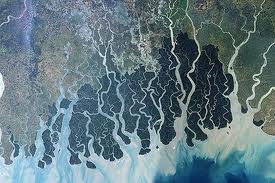With one island nation, Kiribati, already planning an exit strategy, and climatologists and oceanographers marking the steady rise in ocean surface levels, the 21st century looks like it will witness the first definitive impact of global warming. The government of Kiribati recently revealed its purchase of real estate in Fiji for the bulk of its population. Two other island nations, the Maldives in the Indian Ocean and Tuvalu in the Pacific will soon follow Kiribati’s example with their citizens becoming the first climate change refugees in the century.

Rising sea levels are a fact whether we ascribe them to man-made climate change or natural variability. Since the late 19th century the average global rise in sea levels amounts to 20 centimeters (8 inches). When sea levels rise in areas where land is subsiding the potential for storm surges causing significant on land incursions is dramatically heightened. Such is the case in areas like Chesapeake Bay or the Mississippi Delta in Louisiana. The noted rise in sea levels has been steady for much of the last century but recently appears to be accelerating.
Climatologists predict a rise of 30 centimeters (12 inches) over the 21st century. What does that mean for low altitude coastal areas throughout the planet – extensive re-engineering of areas to protect vulnerable populations, or abandonment. For example, in the United States 3.7 million people live within a few feet of sea level. Florida is most vulnerable to the encroaching Atlantic and Gulf of Mexico.
But even a worse fate is in store for Bangladesh on the Bay of Bengal. Rising sea levels recently ended a territorial squabble between that nation and India when the disputed island, known as New Moore in India and South Talpatti in Bangladesh disappeared under the waves. Bangladesh, of all the nations on the planet is most vulnerable to rising sea levels. An average of 11 Bangladeshi citizens lose their homes to rising water every hour. By 2050, 17% of the country will disappear displacing 20 million. Parts of India will submerge by 2020 representing 15% of the Sundarbans region on the Bay of Bengal.









